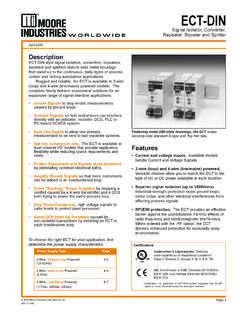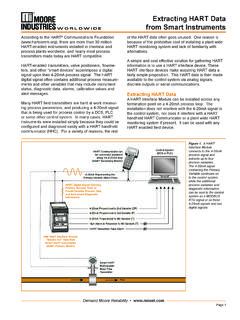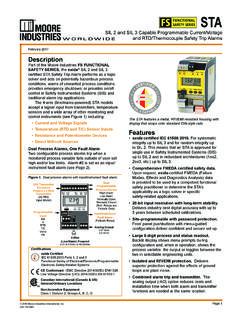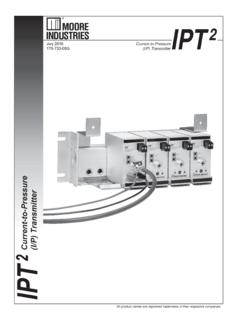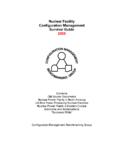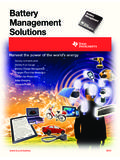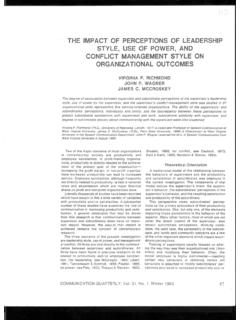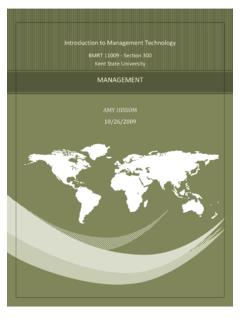Transcription of Power Transducer User’s Guide - Signal Conditioners
1 Power TransducerUser s GuideVolume 1 1991 Moore Industries-International, Inc. Power Transducer user 's GuideVolume 1 Applying Power TransducersNotes 1991 Moore Industries-International, Monitor Power ? .. Definitions .. Concepts of AC Power .. 5IV. Common AC Power Systems .. Common AC Power Systems .. 15VI. Taking Watt and VAR Measurements .. 19 VII. Glossary .. 25 VIII. Reference Charts and InformationA. Transducer output calculations .. 33B. Full-load motor currents .. 35C. Nameplate voltage ratings of standard induction motors .. 36D. Nominal system voltages .. 37IX. Power Transducers available from Moore Industries .. 39 PagePage 40 NotesSpecifications subject to change 1991 Moore Industries-International, Why Monitor Power ?With ac Power consumption and measurement drawing ever-moreattention throughout the process industries, an understanding ofbasic ac parameters becomes increasingly simple reference Guide uses illustrations and simple defini-tions to explain the basics of ac Power and its uses in the processindustries.
2 This comparison shows the relationship between theterms used in measuring electrical current and standard processflow concepts:Electrical TermFlow TermCurrentFlowVoltagePressureResistance Pressure DropKeeping this simple analogy in mind should help you understandand apply the basic principles needed to use Power help in controlling your ac Power usage, or ordering powertransducers, please call your local representative. In addition, ourhelpful Sales Engineers are available during business hours. Pleaseconsult the back of this booklet for the phone number of the officenearest Nameplate Voltage Ratings of StandardInduction MotorsNominal System VoltageNameplate VoltageSingle-Phase Motors:120 .. 115240 .. 230 Three-Phase Motors:208 .. 200240 .. 230480 .. 460600 .. 5752400 .. 23004160 .. 40004800 .. 46006900 .. 660013800 .. 13200 Data taken from IEEE Std. 141-1976 Reference Charts and InformationPage 36 Page 1 1991 Moore Industries-International, Beginning DefinitionsPrior to reading further in this booklet, please familiarize yourselfwith these basic terms of electricity and ac Power The basic unit used to measure current, often abbrevi-ated as amp or A.
3 It equals a unit of electrical current or the rateof flow of electrons. One volt across one ohm of resistance resultsin current flow of one The movement or flow of electrons through a conductor,represented by the letter symbol I. Voltage The force causing current to flow through a conductor,represented by the letter symbol E. The unit of measure is thevolt, or V. One volt equals the force required to produce a currentflow of one ampere through a resistance of one The portion of a Transducer which senses one input eachof voltage and As current flows through a conductor it encountersforce which blocks its path. The force consists of passive compo-nents (resistance) and reactive components (inductive andcapacitive reactance.) Impedance is measured in ohms and thesymbol is Z. Resistance Component of impedance due to passive elements ofthe load. Resistance is represented by the letter symbol R. Oneunit of resistance is known as an Component of impedance due to active elements ofthe load.
4 Symbol is X. Ohm A single ohm equals the amount of impedance that will limitthe current in a conductor to one ampere when one volt is applied tothe conductor, represented by the Greek letter . Frequency The number of times that the variations of an alternat-ing current represented by the sine waveform are repeated duringone second of time, expressed in hertz or Hz. One hertz equalsone cycle per Transducer CalibrationsIf we use the same transducers and transformers as in example 1,and say that the customer has a meter that is already scaled for 0-60,000 watts, we have to work in reverse to determine the appropri-ate calibration point for the Transducer . We would take the 60,000watts and divide this by the transformer ratios:In order to get 60,000 watts full scale with the customer s transform-ers, we would have to calibrate the Transducer to 375 watts 34 Page 3 Reference Charts and Information60,00048012010052 ELEMENTS375 WATTS/ELEMENTX=X 1991 Moore Industries-International, Beginning DefinitionsPrior to reading further in this booklet, please familiarize yourselfwith these basic terms of electricity and ac Power The basic unit used to measure current, often abbrevi-ated as amp or A.
5 It equals a unit of electrical current or the rateof flow of electrons. One volt across one ohm of resistance resultsin current flow of one The movement or flow of electrons through a conductor,represented by the letter symbol I. Voltage The force causing current to flow through a conductor,represented by the letter symbol E. The unit of measure is thevolt, or V. One volt equals the force required to produce a currentflow of one ampere through a resistance of one The portion of a Transducer which senses one input eachof voltage and As current flows through a conductor it encountersforce which blocks its path. The force consists of passive compo-nents (resistance) and reactive components (inductive andcapacitive reactance.) Impedance is measured in ohms and thesymbol is Z. Resistance Component of impedance due to passive elements ofthe load. Resistance is represented by the letter symbol R. Oneunit of resistance is known as an Component of impedance due to active elements ofthe load.
6 Symbol is X. Ohm A single ohm equals the amount of impedance that will limitthe current in a conductor to one ampere when one volt is applied tothe conductor, represented by the Greek letter . Frequency The number of times that the variations of an alternat-ing current represented by the sine waveform are repeated duringone second of time, expressed in hertz or Hz. One hertz equalsone cycle per Transducer CalibrationsIf we use the same transducers and transformers as in example 1,and say that the customer has a meter that is already scaled for 0-60,000 watts, we have to work in reverse to determine the appropri-ate calibration point for the Transducer . We would take the 60,000watts and divide this by the transformer ratios:In order to get 60,000 watts full scale with the customer s transform-ers, we would have to calibrate the Transducer to 375 watts 34 Page 3 Reference Charts and Information60,00048012010052 ELEMENTS375 WATTS/ELEMENTX=X 1991 Moore Industries-International, Basic Concepts of Ac PowerThis material should give non-electrical engineers a feel for some ofthe basic characteristics of electrical systems.
7 Ideally, this informa-tion will help you implement and work with an energy monitoring andmanagement Direct Current CircuitIn a direct current circuit voltage and current are constant. Thereare only resistive loads. The relationship between voltage, currentand resistance is E = IR. Power is defined P = EI = I2R. A watt isone volt times one amp. 1W = (1V) (1A). Power Alternating Current CircuitAlternating current is created by rotating a coil of conductive wirethrough a magnetic field (Drawing 1). Drawing 2 represents theresults of the rotating action through the magnetic field. In an accircuit, voltage and current vary in amplitude in a sinusoidal 1. Typical ac motorGlossaryVolt-ampere-reactive-hour The measure of the number of VAR sused in one hour. VAR-hr and whr are frequently used to calculateaverage Power factor during a billing (V) The force which causes current to flow through aconductor. One volt equals the force required to produce a currentflow of one ampere through a resistance of one (W) A measure of real Power .
8 The unit of electric powerrequired to do work at the rate of one joule per second. It is thepower expended when one ampere of direct current flows through aresistance of one demand The usual demand billing factor where peak aver-age demand is measured in watts or real (whr) A unit of electrical work indicating the expendi-ture of one watt of electrical Power for one An instrument for measuring the real Power in anelectric circuit. Its scale is usually graduated in watts, kilowatts, 32 Page 5 SlipringBrushRotating ConductorDirectionof rotationUniformMagneticFieldLoad 1991 Moore Industries-International, 2. One rotation of an ac motorResistive LoadWhen this coil is wired to a purely resistive load, the voltage and theresulting current occur simultaneously. In other words, they arerotating in phase (Drawing 3).Drawing 3. Resistive LoadSliding demand interval A method of calculating average de-mand by averaging the demand over several successive short timeintervals, advancing one short time interval each time.
9 Updatingaverage demand at short time intervals gives the utility a muchbetter measure of true demand and makes it difficult for the cus-tomer to obscure high short-term billing factors Secondary billing factors in a rateschedule, including such things as fuel-adjustment costs, multiplemetering points, interruptible service provisions, and transformerownership clauses Rate schedule provisions which varyrates depending on the time of day or time of year when energy isconsumed. Frequently these clauses cover both demand andenergy charges. There is money to be saved by operating highloads and consuming high amounts of energy during off-peakperiods when rates are Power Same as real loads A situation existing in an alternating currentsystem using more than two current-carrying conductors whereuneven loading of the phases results in unequal current in thecurrent-carrying (VA) The unit of apparent Power . It equals volts xamperes, regardless of the Power demand Where peak average demand is measuredin volt-amperes rather than watts.
10 In this case the customer isautomatically penalized for operating at any Power factor less (VAR) The unit of reactive Power , asopposed to real Power , in watts. One VAR is equal to one demand Measuring VAR demand is amethod of penalizing for poor Power factor. Multiplying by somerate ($/VAR) penalizes for operating at any Power less than there is a quantity of free VAR which is determinedas some percentage of the peak average watt demand. All excessVAR over this quantity is then billed at this $/VAR rate. Effectively,this penalizes for operating below some specified Power factor lessthan 6 Basic Concepts of Ac PowerGlossaryPage 31E0 IE0 One Rotation +360 1991 Moore Industries-International, Concepts of Ac PowerThe Power is defined as P = EI cos , where is the phase anglebetween the voltage and current. Here (Drawing 4) the angle iszero. Cos = 1, so P = EI and alternates between some positivevalue and 4 shows instantaneous values of the voltage, current,and Power .
